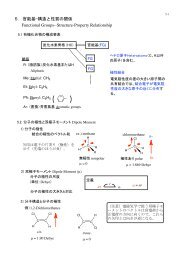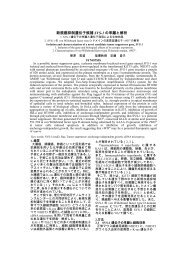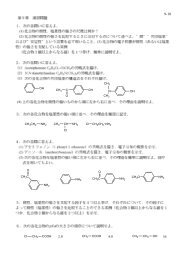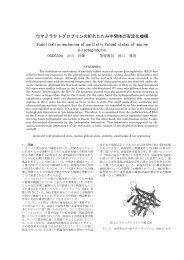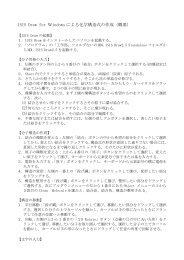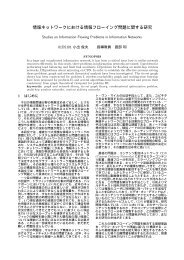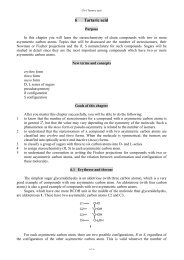You also want an ePaper? Increase the reach of your titles
YUMPU automatically turns print PDFs into web optimized ePapers that Google loves.
Ch 6 Gases<br />
6 <strong>GASES</strong><br />
Gases are one of the three states of matter, and while this state is indispensable for chemistry's<br />
study of matter, this chapter mainly considers the relationships between volume, temperature and<br />
pressure in both ideal and real gases, and the kinetic molecular theory of gases and thus, is not<br />
directly very chemical. The treatment is primarily about physical change, and chemical reactions are<br />
not discussed.<br />
However, the physical properties of gases depend on the structures of their gaseous molecules<br />
and the chemical properties of gases also depend upon their structures. The behavior of gases that<br />
exists as single molecules is a good example of the dependence of the macroscopic properties of<br />
matter on microscopic structure.<br />
6.1 The ideal gas law<br />
(a) Propertiessa of gases<br />
The properties of gases can be summarized as below.<br />
Property of gases<br />
(1) Gases are transparent.<br />
(2) Gases distribute uniformly in a vessel whatever shape it may have.<br />
(3) Gases in a container exert pressure on its walls.<br />
(4) The volume of a given amount of gas is equal to the volume of its container. If a gas is not<br />
confined in a vessel, the volume of the gas will become infinitely large, and its pressure will<br />
become infinitely small.<br />
(5) Gases diffuse in all directions regardless of the presence or absence of external pressure.<br />
(6) When two or more gases mix, they distribute uniformly.<br />
(7) Gases can be compressed by external pressure. If the pressure is reduced, the gas will expand.<br />
(8) Gases will expand if heated, and will shrink if cooled.<br />
Of the properties described above, the most significant is the pressure of a gas. Suppose a liquid<br />
fills a vessel. If the liquid is cooled and its volume is reduced, the liquid cannot fill the vessel<br />
completely any more. However, a gas fills the container regardless of the change in temperature.<br />
However, the pressure the gas exerts on the wall will change.<br />
A device to measure the pressure of a gas is called a manometer. The prototype is the<br />
barometer invented by Torricelli to measure the atmospheric pressure.<br />
Pressure is defined as force per unit area; thus<br />
pressure = force/area<br />
In SI, the unit of force is the Newton (N), the unit of area is m 2 , and that of pressure is Pascal<br />
(Pa). 1 atm is ca. 1013 hPa.<br />
1 atm = 1.01325 x 10 5 Pa = 1013.25 hPa<br />
However, the non-SI unit, Torr, i.e., 1/760 of 1 atm, is frequently used to record pressure during<br />
chemical experiments.<br />
(b) Volume and pressure<br />
The fact that the volume of a gas changes with changes in pressure was noticed as early as the<br />
17 th century by Torricelli and the French philosopher/scientist Blase Pascal (1623-1662). Boyle<br />
observed, by applying pressure with a mercury column, that the volume of a gas confined in a glass<br />
tube sealed at one end decreases. In this experiment, the volume of the gas was measured at<br />
1(10)
Ch 6 Gases<br />
pressures higher than 1 atm.<br />
Boyle constructed a vacuum pump using the highest techniques of his day, and he observed that<br />
the gas at pressures below 1 atm expanded. After he carried out a wide range of experiments, Boyle<br />
proposed Eq. (6.1) to describe the relation between the volume V and the pressure P of a gas. This<br />
equation is called Boyle’s law.<br />
PV = k (a constant) (6.1)<br />
The graphical presentation of Boyle’s experiments can be done in two ways. If P is plotted as<br />
ordinate and V as abscissa, a hyperbola is obtained (Fig. 6.1(a)). If V is plotted against 1/P, a straight<br />
line is obtained (Fig. 6.1(b)).<br />
Figure 6.1 Boyle’s law.<br />
(a) Plot of the results of an experiment; pressure vs. volume<br />
(b) Plot of the results of an experiment; volume vs.1/pressure. Note the slope k is constant.<br />
(c) Volume and temperature<br />
It was more than a century after Boyle that scientists began to take interest in the relation<br />
between the volume and the temperature of a gas. It was probably because thermal balloons became<br />
the talk of the town at that time. The French chemist Jacques Alexandre César Charles (1746-1823),<br />
a famous balloon navigator at that time, recognized that, at constant pressure, the volume of a gas<br />
increased as the temperature increased. This relation was called Charles’s law, though his data were<br />
not necessarily quantitative. Gay-Lussac later plotted the volume of a gas against the temperature<br />
and obtained a straight line (Fig. 6.2). For this reason Charles’s law is sometimes called Gay-<br />
Lussac's law. Both Charles’ law and Gay-Lussac's law held approximately well for all gases so long<br />
as liquefaction did not take place.<br />
2(10)
Ch 6 Gases<br />
Figure 6.2 Charles’s law.<br />
Plot of the volume of several gases against temperature. Solid lines are based on experimental data and the<br />
dotted lines are obtained by extrapolating the experimental values. The amount of gas varies.<br />
An interesting discussion can be drawn from Charles’s law. By extrapolating the plot of the<br />
volume of gases against temperature, the volumes became zero at a certain temperature. It is<br />
interesting that the temperature at which the volumes become zero is ca. -273°C (the exact value is -<br />
273.2°C) for all gases. This indicates that at a constant pressure, two straight lines obtained by<br />
plotting the volume V 1 and V 2 of two different gases 1 and 2 against the temperature will intersect at<br />
V = 0.<br />
The British physicist Lord Kelvin (William Thomson (1824-1907)) proposed that at this<br />
temperature the molecules of gases become essentially motionless and hence its volume becomes<br />
negligible as compared with that at ambient temperatures, and he proposed a new scale of<br />
temperature, the Kelvin temperature scale, which is defined by the following equation.<br />
273.2 + °C = K (6.2)<br />
Today the Kelvin temperature K is called the absolute temperature, and 0 K is called the<br />
absolute zero point. Using the absolute temperature scale, Charles’s law may be expressed by a<br />
simple equation as shown below.<br />
V = bT (K) (6.3)<br />
where b is a constant independent of the type of gas.<br />
According to Kelvin, temperature is a measure of molecular motion. In this regard, absolute<br />
zero is particularly interesting since at this temperature, molecular motion of gases would cease.<br />
Absolute zero has never been realized by experiments. The lowest temperature ever attained is<br />
believed to be ca. 0.000001K.<br />
Avogadro thought that for all gases compared under conditions of equal temperature and<br />
pressure, equal volumes would contains the same number of molecules (Avogadro’s low; Ch. 1.2(b)).<br />
This is equivalent to assuming that the real volume of any gas is negligibly small as compared with<br />
the volume that the gas occupies. If this assumption is correct, the volume of a gas is proportional to<br />
the number of molecules of the gas contained in that volume. Hence, the relative mass, i.e., the<br />
atomic weight or molecular weight of a gas, can easily be obtained.<br />
(d)<br />
Equations of state for ideal gases<br />
The essence of the three gas laws is summarized below. By the three laws, the relation between<br />
3(10)
Ch 6 Gases<br />
temperature T, pressure P and volume V of n mols of gas is clearly shown.<br />
Boyle’s law<br />
V = a/P (at constant T, n)<br />
Charles’s law<br />
V = bT (at constant P, n)<br />
Avogadro’s law<br />
V = cn (at constant T, P)<br />
Three gas laws<br />
Thus, V is proportional to T and to n, and is inversely proportional to P. The relation can be<br />
combined into one equation Eq. (6.4) or (6.5).<br />
or<br />
V = RTn/P (6.4)<br />
PV = nRT (6.5)<br />
where R is a new constant. The above equation is called the equation of state of ideal gases or<br />
simply the ideal equation of state.<br />
The value of R when n = 1 is called the gas constant, which is one of the fundamental physical<br />
constants. The value of R is various depending on the unit used. In the metric system, R =<br />
8.2056x10 -2 dm 3 atm mol -1 K -1 . Today, the value R = 8.3145 J mol -1 K -1 is more frequently used.<br />
Sample Exercise 6.1 The ideal equation of state<br />
A sample of 0.06 g of methane CH 4 has a volume of 950 cm 3 at a temperature of 25°C.<br />
Calculate the pressure (Pa or atm).<br />
Answer<br />
Since the molecular weight of CH 4 is 16.04, the amount of substance n is given as;<br />
n = 0.60 g/16.04 g mol -1 = 3.74 x 10 -2 mol<br />
Then,<br />
P = nRT/V = (3.74 x10 -2 mol)(8.314 J mol -1 K -1 ) (298 K)/ 950 x 10 -6 m 3 )<br />
= 9.75 x 10 4 J m -3 = 9.75 x 10 4 N m -2<br />
= 9.75 x 10 4 Pa = 0.962 atm<br />
With the aid of the gas constant, the unknown molecular weight of a gas can easily be<br />
determined if the mass w, the volume V and the pressure P are known. If the molar mass of the gas is<br />
M (g mol -1 ), Eq. (6.6) is obtained because n = w/M.<br />
Then<br />
PV = wRT/M (6.6)<br />
M = wRT/PV (6.7)<br />
Sample Exercise 6.2 Molecular weight of a gas<br />
The mass of an evacuated container with a volume of 0.500 dm 3 is 38.7340 g, and the mass<br />
increases to 39.3135 g after it is filled with air at a temperature of 24°C and a pressure of 1 atm.<br />
Assuming air is an ideal gas (i.e., Eq. (6.5) can be applied), calculate the apparent molecular weight<br />
of air.<br />
4(10)
Ch 6 Gases<br />
Answer<br />
28.2. Since this is such an easy exercise, the details of the solution are not given. You can<br />
obtain the same value from the composition of air (approximately N 2 :O 2 = 4:1)<br />
(e) Law of partial pressures<br />
In many cases you will be dealing not with pure gases but with mixed gases containing two or<br />
more gases. Dalton was concerned with humidity and was thus interested in wet air, that is, mixtures<br />
of air and water vapor. He derived the following relation by assuming that each gas in the mixture<br />
behaved independently of the other.<br />
Suppose a mixture of two kinds of gases A (n A mol) and B (n B mol) has a volume of V at a<br />
temperature T. The following equations can be obtained for each gas.<br />
p A = n A RT/V (6.8)<br />
p B = n B RT/V (6.9)<br />
where p A and p B are called the partial pressures of gas A and gas B, respectively. The partial<br />
pressure is the pressure that a component in the mixed gas would exert if it were alone in the<br />
container.<br />
Dalton proposed the law of partial pressures which states that the total pressure P that the<br />
gas exerts is equal to the sum of the partial pressures of the two gases. Thus,<br />
P = p A + p B = (n A + n B )RT/V<br />
(6.10)<br />
This law indicates that in a mixed gas each component gas exerts pressure completely<br />
independently. Though several gases are present, the pressure each gas exerts is not influenced by<br />
the presence of other gases.<br />
If the molar fraction of gas A, x A , in the mixture is defined as x A = n A /(n A + n A ), then p A can be<br />
expressed in terms of x A .<br />
p A = [n A /(n A + n B )]P (6.11)<br />
In other words, the partial pressure of each component gas is the product of the molar fraction, in<br />
this case x A , and the total pressure P.<br />
The saturated vapor pressure (or simply vapor pressure) of water is defined as the maximum<br />
value of partial pressure that can be exerted by water vapor at a given temperature in a mixture of air<br />
and water vapor. If more vapor is present, all the water cannot remain as a vapor and part of it<br />
condenses.<br />
Sample exercise 6.3 Law of partial pressures<br />
A 3.0 dm 3 flask contains carbon dioxide CO 2 at a pressure of 200 kPa, and another 1.0 dm 3<br />
flask contains nitrogen N 2 at a pressure of 300 kPa. The two gases are transferred into a 1.5 dm 3<br />
flask. Calculate the total pressure of the mixed gas. The temperature is kept constant throughout the<br />
experiment.<br />
Answer<br />
The partial pressure of CO 2 will be 400 kPa since the volume of the new flask is 1/2 of the<br />
previous flask while that of N 2 is 300 x (2/3) = 200 kPa since the volume is now 2/3. Then the total<br />
pressure is 400 + 200 = 600 kPa.<br />
6.2 Ideal gases and real gases<br />
5(10)
Ch 6 Gases<br />
(a) Equation of state of van der Waals<br />
Gases which follow Boyle’s law and Charles’ law, that is, the ideal equation of state (Eq. (6.5)),<br />
are called ideal gases. It was found, however, that gases that we encounter, i.e., real gases, do not<br />
strictly follow the ideal equation of state. The lower the pressure of the gas at constant temperature,<br />
the smaller the deviation from ideal behavior. The higher the pressure of the gas, or in other words,<br />
the smaller the intermolecular distances, the larger the deviation.<br />
At least two reasons may account for this deviation. First, the definition of the absolute<br />
temperature is based on the assumption that the real volume of gases is negligibly small. Molecules<br />
of gases should have some actual volume even though if it may be extremely small. Furthermore, as<br />
the intermolecular distances become smaller, some kind of intermolecular interaction should arise.<br />
The Dutch physicist Johannes Diderik van der Waals (1837-1923) proposed an equation of state<br />
for real gases, which is known as the van der Waals equation or the van der Waals equation of<br />
state. He modified the equation of state for an ideal gas (Eq. 6.5) in the following ways: added to the<br />
pressure term P a correction to compensate for intermolecular interaction; subtracted from the<br />
volume term V a correction to account for the real volume of the gas molecules. Thus,<br />
[P + (n 2 a/V 2 )] (V - nb) = nRT (6.12)<br />
where a and b are experimentally determined values for each gas and called van der Waals<br />
constants (Table 6.1). Smaller values for a and b indicate that the behavior of the gas should be<br />
closer to the behavior of an ideal gas. The magnitudes of a values are also related to the relative ease<br />
of liquefying the gas.<br />
Table 6.1 Values of van der Waals constants for some common gases<br />
gas a (atm dm 6 mol -2 ) b (dm 3 mol –1 ) gas a (atm dm 6 mol -2 ) b (dm 3 mol –1 )<br />
He 0.0341 0.0237 C 2 H 4 4.47 0.0571<br />
Ne 0.2107 0.0171 CO2 3.59 0.0427<br />
H 2 0.244 0.0266 NH 3 4.17 0.0371<br />
N 2 1.39 0.0391 H 2 O 5.46 0.0305<br />
CO 1.49 0.0399 Hg 8.09 0.0170<br />
O 2 1.36 0.0318<br />
Sample exercise 6.4 Ideal gas and real gas<br />
A sample of 10.0 mols of carbon dioxide is contained in a 20 dm 3 container and vaporized at a<br />
temperature of 47°C. Calculate the pressure of carbon dioxide (a) as an ideal gas and (b) as a real<br />
gas. The experimental value is 82 atm. Compare this value with your results.<br />
Answer<br />
The pressure as an ideal gas can be calculated as follows:<br />
P = nRT/V = [10.0 (mol) 0.082(dm 3 atm mol -1 K -1 ) 320(K)]/(2.0 dm 3 ) = 131 atm<br />
The value obtained by using Eq. 6.11 is 82 atm which is identical with the experimental value.<br />
The results seem to indicate that a polar gas such as carbon dioxide will not behave ideally at a high<br />
pressure.<br />
(b) Critical temperature and critical pressure<br />
Since water vapor easily condenses into water, it was long expected that all gases could be<br />
liquefied if cooled and a pressure applied. However, it turned out that gases existed which could not<br />
be liquefied no matter what pressure was applied so long as the temperature of the gas was above a<br />
certain temperature called the critical temperature. The pressure required to liquefy a gas at the<br />
critical temperature was called the critical pressure, and the state of matter in which the<br />
6(10)
Ch 6 Gases<br />
temperature and the pressure have their critical values is called the critical state.<br />
The critical temperature is determined by the intermolecular attractions between gaseous<br />
molecules. Accordingly the critical temperature of nonpolar molecules is generally low. Above the<br />
critical temperature, the kinetic energy of gaseous molecules is much larger than the intermolecular<br />
attraction and hence liquefaction does not take place.<br />
Table 6.2 Critical temperature and critical pressure of some common gases<br />
gas critical<br />
temperature(K)<br />
critical<br />
pressure(atm)<br />
gas critical<br />
temperature(K)<br />
critical<br />
pressure(atm)<br />
H 2 O 647.2 217.7 N 2 126.1 33.5<br />
HCl 224.4 81.6 NH 3 405.6 111.5<br />
O 2 153.4 49.7 H 2 33.3 12.8<br />
Cl 2 417 76.1 He 5.3 2.26<br />
(c) Liquefaction of gases<br />
Among the pressure correction terms a of van der Waals constants, H 2 O, ammonia and carbon<br />
dioxide have large values, while oxygen and nitrogen and other gases have intermediate values. The<br />
value for helium is very small.<br />
It was once known that liquefying nitrogen and oxygen was difficult. In the 19 th century, it was<br />
found that such newly discovered gases such as ammonia were liquefied relatively easily. This<br />
finding prompted attempts to liquefy other gases. Liquefaction of oxygen or nitrogen by cooling<br />
under pressure was not successful. Such gases were regarded as “permanent gases” which could<br />
never be liquefied.<br />
Later the existence of the critical temperature and critical pressure was discovered. That meant<br />
there should not be any permanent gases. Some gases are easily liquefied and others not. In the<br />
liquefaction of gases on an industrial scale, the Joule-Thomson effect is employed. When a gas<br />
confined in a well-insulated vessel is rapidly compressed by pushing down a piston, the kinetic<br />
energy of the moving piston increases the kinetic energy of the molecules in the gas, raising its<br />
temperature (since this is an adiabatic process, no kinetic energy is transferred to the wall of the<br />
vessel, etc.). This process is called adiabatic compression. If the gas then is expanded rapidly<br />
through an orifice, the temperature of the gas decreases. This is adiabatic expansion. It is possible<br />
to cool a gas by alternatively repeating rapid adiabatic expansions and compressions till liquefaction<br />
takes place.<br />
In a chemical laboratory, ice, or a mixture of ice and salt, or a mixture of dry ice (solid CO 2 )<br />
and acetone are used as coolants. When lower temperatures are required, liquid nitrogen is<br />
appropriate because it is stable and relatively cheap.<br />
6.3 Kinetic molecular theory of gases<br />
The problem, why gas laws are valid for all gases, was explained by physicists at the end of the<br />
19 th century by the atomic theory. The crucial point of their theory was that the origin of the pressure<br />
of gases is the movement of gaseous molecules. Hence the theory is called the kinetic molecular<br />
theory of gases.<br />
According to this theory, the gas exerts pressure by its molecules colliding against the walls of<br />
the vessels. The larger the number of gaseous molecules in a unit volume, the larger the number of<br />
molecules that collide against the walls of the vessel, and as a result, the higher the pressure of the<br />
gas. The assumptions of this theory are as follows.<br />
7(10)
Ch 6 Gases<br />
Assumptions of kinetic molecular theory<br />
(1) Gases are composed of molecules moving randomly.<br />
(2) There is neither attraction nor repulsion among the gaseous molecules.<br />
(3) Collisions between molecules are perfect elastic collisions, i.e., no kinetic energy is lost.<br />
(4) As compared with the volume that the gas occupies, the real volume of the gaseous molecules is<br />
negligible.<br />
Based on these assumptions, the following equation can be derived for a system composed of n<br />
molecules with a mass of m.<br />
PV = nmu 2 /3 (6.13)<br />
where u 2 is the mean square velocity. It is clear that the form of Eq. 6.13 is identical with that of<br />
Boyle’s law. Indeed, if u 2 is a constant at constant temperature, the equation is a variation of<br />
Boyle’s law<br />
Eq. 6.13 indicates that the velocity of the gas molecule is a function of PV. Since the value of<br />
PV for a given amount of gas is constant, it is possible that the velocity of the gas molecule is related<br />
to the mass of the gas, i.e., molecular weight. For 1 mol of a gas, the following equation can be<br />
derived.<br />
PV m = N A mu 2 /3 (6.14)<br />
where V m is the molar volume and N A is the Avogadro constant. By substituting PV m = RT in Eq.<br />
6.14, the following equation is obtained.<br />
1<br />
2<br />
N A mu 2 =<br />
3<br />
RT<br />
2 (6.15)<br />
The left side of the equation corresponds to the kinetic energy of the gas molecules. From this<br />
equation, the root mean square velocity of gases √ u 2 can be obtained.<br />
√2<br />
u<br />
3RT<br />
= √NA<br />
m<br />
= √<br />
3RT<br />
M (6.16)<br />
Sample exercise 6.5 Root mean square velocity of gases<br />
Determine the root mean square velocity of a hydrogen molecule H 2 at S.T.P. ( = standard<br />
temperature and pressure; 25°C, 1 atm).<br />
Answer<br />
The molar mass of hydrogen is 2.02 g mol -1 . Then<br />
√2<br />
u<br />
=<br />
3RT 3 x 8.31 x 298<br />
√<br />
=<br />
M √ 2.02 x 10<br />
-3<br />
= 1.92 x 10 3 m s -1<br />
If the root mean square velocity of gas molecules can be approximately proportional to the<br />
diffusion velocity as determined by experiment, it may be possible to determine the molecular<br />
weight of a gas A whose molecular weight is not yet known by comparing the diffusion velocity of<br />
8(10)
Ch 6 Gases<br />
A with that of a gas B whose molecular weight is already known.<br />
If you reverse the left side and right side of Eq. 6.15, you will obtain the following equation.<br />
3 1<br />
N A mu 2<br />
2 RT = 2<br />
(6.17)<br />
This equation clearly indicates that in terms of kinetic molecular theory, the temperature is a<br />
measure of the intensity of molecular motion.<br />
Exercise<br />
6.1 Boyle’s law and Charles’s law<br />
A sample of methane CH 4 has a volume of 7.0 dm 3 at a temperature of 4°C and a pressure of<br />
0.848 atm. Calculate the volume of methane at a temperature of 11°C and a pressure of 1.52 atm.<br />
6.1 Answer<br />
V = [0.848 (atm) x 7.0 (dm 3 ) x 284(K)]/[1.52 (atm) x 277(K)] = 4.0 dm 3<br />
6.2 Law of gaseous reactions<br />
The molecular formula of a gaseous hydrocarbon is C 3 H x . When 10 cm 3 of this gas was reacted<br />
with excess oxygen at a temperature of 110°C and a pressure of 1 atm, the volume increased to 15<br />
cm 3 . Estimate the value of x.<br />
6.2 Answer<br />
The equation for the perfect combustion of hydrocarbons is as follows.<br />
C 3 H x (g) +<br />
x<br />
3 + 4<br />
O 2<br />
3CO 2 (g) + x 2 H 2O(g)<br />
The volume of oxygen required for the perfect combustion of 10 cm 3 of hydrocarbon is (30 +(5x/2))<br />
cm 3 and the volume of CO 2 and vapor generated is 30 cm 3 and 5x cm 3 , respectively. Then the total<br />
balance of gases is given below where a is the volume of excess oxygen.<br />
30 + 5x + a = 5 + 10 + (5x/2) + a ∴ x = 6<br />
The hydrocarbon is propene C 3 H 6 .<br />
6.3 Gas constant<br />
1 mol of an ideal gas occupies 22.414 dm 3 at the temperature of 0°C and the pressure of 1 atm.<br />
Using this data, calculate the gas constant in dm 3 atm mol -1 K -1 and in J mol -1 K -1 .<br />
6.3 Answer<br />
0.0821 dm 3 atm mol -1 K -1 , 8.314 J mol -1 K -1 .<br />
6.4 Equation of state<br />
A 0.2000 dm 3 flask contains 0.3000 mol of helium at a temperature of -25°C. Calculate the<br />
pressure of helium in two ways.<br />
(a) With the aid of the equation for an ideal gas<br />
(a) With the aid of the equation for a real gas<br />
6.4 answer<br />
(a) 30.6 atm, (b) 31.6 atm. For gases such as helium, the error involved in treating it as an ideal<br />
gas is very small (3 % in this case).<br />
6.5 Velocity of gases<br />
It can be assumed that the velocity of the diffusion of gases is determined by the root mean<br />
9(10)
Ch 6 Gases<br />
square velocity. How fast can He diffuse as compared with a molecule of NO 2 <br />
6.5 Answer<br />
By using Eq. 6.16, you can obtain the following relation.<br />
√M He /M NO 2<br />
= velocity NO /velocity<br />
2 He<br />
The ratio is 0.295, which means that He can diffuse ca. 3.4 times as fast as NO 2 .<br />
6.6 General problem for gases<br />
Suffix 1 and 2 correspond to gas 1 and gas 2. Choose the larger one for each question.<br />
(a) u 1 or u 2 when T 1 = T 2 and M 1 > M 2<br />
(b) N 1 or N 2 when P 1 = P 2 , V 1 = V 2 , T 1 = T 2 and M 1 > M 2<br />
(c) V 1 or V 2 when N 1 = N 2 , T 1 = T 2 and P 1 > P 2<br />
(d) T 1 or T 2 when P 1 = P 2 , V 1 = V 2 and N 1 > N 2<br />
(e) P 1 or P 2 when V 1 = V 2 , N 1 = N 2 , u 1 = u 2 and M 1 > M 2<br />
where P is the pressure, V the volume, T the temperature, M the molar mass, u the root mean square<br />
velocity and N is the number of molecules in the volume V.<br />
6.6 Answer<br />
(a) u 1 < u 2 (b) N 1 = N 2 (c) V 1 < V 2 (d) T 1 < T 2 (e) P 1 > P 2<br />
10(10)



